Message of the Day: Human Rights, War
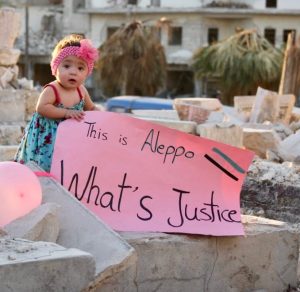
Sama al-Kateab, Allepo, 2016, The Observer, 25 August 2019
Comfort the afflicted. Afflict the comfortable.
The former requires the latter.
So, in the late days of August for the comfortable, we bring affliction.
Fix your eyes on a baby girl in Syria. Then on her millions of sisters and brothers. And then millions of adults suffering, dying, resisting, running to save the children and themselves when they can, endlessly.
Three million people are at risk as we write in Syria, in the northern Idlib province. Actually, many more. This on top of the hundreds of thousands of deaths and millions of displaced refugees over the past several years, in what has often been described as the greatest catastrophe of its kind since World War Two.
The proximate cause has been the butchery of the Bashar Al-Assad dictatorship in collusion with Russia and Iran, drawing in or chasing out and enabled by–everyone–including US policy or the lack thereof, and that of the UK and Europe as well. ISIS and other extremist groups were launched or kept alive by the Syrian blood bath, with the original moderate majority of Syrians in resistance increasingly destroyed; Turkey has been pulled and pulls in all directions and is dealing with millions of refugees; Israel and Iran are increasingly at war in Syria, Iraq and Lebanon; the Saudis in Yemen are an offshoot of this chaos in many ways; Jordan is over-run with refugees. And the next wave is headed for Europe, again.
History and karma redux, maybe times Armageddon.
As we’ve noted during our series, The End Of Civilization As We Knew It, a direct line can be drawn from Syria to the hyper-sped up disintegration of the international order and values at least aspired to in the World War Two aims in defeating fascism. Of course, it was a moment as a lever created by many forces and events over many years. As we’ve pointed out relentlessly, the lack of equality in basic needs and rights for all is at the core of what’s occurred. And the context of the age of weapons of mass destruction and now the digital age has amplified everything in ways that can’t be overstated.
Any possibility of hope and survival as a species starts with not averting our eyes.
Today, we focus on what has happened and is happening, in Syria.
We salute The Observer in London for forcing us to not avert our eyes.
Here are two articles from Sunday’s edition.
The first is an editorial. It sums up the situation briefly and powerfully. It is critical that the reader go to the links in the editorial, and then the links in the linked articles, which go back years, for a full view of what has occurred. It will be a fair amount of reading, but compared to what? Being a baby girl in Syria running from Assad’s bombs?
The second is an interview with and overview from award-winning Syrian journalist Waad al-Kateab–a revelatory read and experience. Her new documentary film is a history of what has happened in Syria, from the most human on the ground perspective possible. As a mother, with the film dedicated to her daughter, born in Aleppo in 2016, and featured in the film.
Aleppo.
A place that made the White Helmets famous.
A place that compelled courageous journalists of the likes of CNN’s chief international correspondent, Clarissa Ward, while reporting from what WBUR’s profile of her called “the most dangerous country in the world”, to beg the audience and the world to wake up and act.
A place, and a word, that will, with certainty, echo through history.
Even more so in the future, if there is one, when individuals in the main value the learning and memory of it once again.
The documentary by al-Kateab, For Sama, which won Best Documentary at Cannes this year and other such awards, is opening at cinemas starting in Portland in 48 hours, then throughout the UK, and broadcast there on Channel 4 and on the acclaimed PBS Frontline in the US in the Fall.
Keep your eyes on the venues and schedules.
Do.Not.Miss.It.
Here are the articles:
“The Observer view on Syria and the west’s shameful failure to act”
Editorial, The Observer, London, 25 August 2019
The slaughter in Idlib is intensifying and millions have nowhere to go. The whole stability of the Middle East is at risk
The crisis in Syria does not feature high on the agenda at this weekend’s G7 summit in Biarritz. The absence of two key players – Russia and Turkey – means any substantive initiatives are unlikely. Donald Trump has washed his hands of the conflict, although Pentagon chiefs are resisting his demand to withdraw all US forces. European leaders, beset by many other urgent problems, seem to prefer not to think about Syria at all.
This attitude is intolerably shortsighted. Western governments’ neglect of the eight-year war and, in particular, its impact on civilians is a sadly familiar phenomenon, but no more acceptable for being predictable. Their involvement has been sporadic and uneven, spurred from time to time by headline events such as chemical weapons attacks or war crimes too horrific to ignore. The campaign against Islamic State (Isis) was given priority.
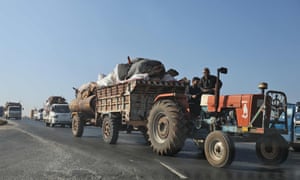
The price of this collective failure to tackle head-on one of the greatest strategic challenges of our time is now being paid, once again, by Syria’s population. In Idlib, north-west Syria, more than 3 million people are under fire from Syrian regime forces, backed by Russian bombers and artillery. More than 800 noncombatants have died since April. At least half-a-million civilians, many previously displaced, have fled towards the Turkish border.
Despite repeated appeals for help by the UN, aid agencies and local organisations such as the White Helmets, the slaughter and mayhem are intensifying following last week’s fall to Bashar al-Assad’s troops of the southern Idlib town of Khan Sheikhoun. The plight of the fleeing population is compounded by Turkey’s reluctance to accept more refugees and its determination to force many among 3.6 million Syrians already in Turkey out of the big cities and back across the border.
If not out of compassion then for reasons of narrow self-interest, western leaders must pay more attention. Recep Tayyip Erdoğan, Turkey’s president, has helped hold the line in Idlib since last year, when he set up military observation posts to keep regime forces, rebels and jihadists apart. But this arrangement is falling apart. Last week a Turkish convoy was attacked, prompting Erdoğan to seek an emergency meeting with Vladimir Putin, his Russian counterpart.
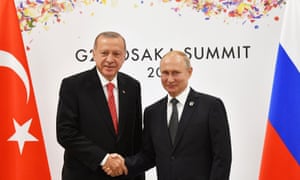
If a politically weakened Erdoğan loses patience, the consequences could be dire. In line with previous Turkish operations in al-Bab, Afrin and Azaz, he could order more military incursions into Syria to create what Ankara calls refugee “safe havens”. He may further challenge the pro-western Syrian Kurds’ control of areas east of the Euphrates. And by blocking the main escape route for Idlib’s civilians, he could trigger another mass refugee exodus in the direction of Europe, similar to what happened in 2015.
All this matters greatly for the wider stability of the Middle East. Despite Turkey’s view of them as terrorists, Syria’s Kurds, backed on the ground by US and British special forces, are a vital element in the unfinished fight against Isis. Reports across the region speak of a significant Isis resurgence in northern Syria and Iraq. Sleeper cells have reportedly mounted 43 attacks in Syrian Kurdish areas since late July. There is even a suspicion that Turkey is covertly assisting them.
At the same time Israel, with Trump’s blessing and possibly Putin’s too, is using Syrian chaos to widen an undeclared war with Iran. It has launched numerous airstrikes on Iranian forces and their proxies inside Syria. Now it is expanding its campaign to include Iranian targets in Iraq. Munitions warehouses and a military base north of Baghdad used by Iran’s Revolutionary Guards were hit in recent, unacknowledged Israeli strikes. These escalations presage ever-deepening instability.
Idlib, Isis, Israel-Iran: it is a toxic mix. And all are byproducts of the west’s abject failure to move decisively to halt the Syrian war.
. . .
“‘My daughter was raised during the siege of Aleppo. I had to make a film for her’”
Kate Kellaway, Documentary films, The Observer, London, 25 August 2019
For Sama, a new documentary from award-winning Syrian journalist Waad al-Kateab, has won global acclaim. She talks about filming and family life on the frontline
The camera focuses on Sama’s face. She is the sweetest baby and looks, at first glance, as though her life might be ordinary. Her eyes are a transitory newborn colour, greyish green, waiting to turn brown. Her gold earrings look over-large in her tiny ears. Sama means sky in Arabic – a sky, as her mother imagines it, where no bombs fall, with ordinary clouds and sunshine. So far, this is footage that could be the work of any doting parent, but Sama’s mother is journalist Waad al-Kateab and this is her documentary For Sama, filmed during the Syrian war. In the film al-Kateab sings a lullaby that almost lulls us – if not Sama – into a false sense of security. Sama is chewing her toe investigatively, as babies do, when a tank shell explodes. It sounds like a nightmare next-door neighbour heaving heavy furniture about and there is a shout: “Downstairs, downstairs, there’s another one coming…” It is the summer of 2016, the beginning of the siege of Aleppo. The camera loses focus, swerves incoherently. Al-Kateab calmly asks someone to “take Sama”. By now, the shells are deafening.
“This is insane – we’re getting this every day,” she goes on in her low, musical voice – her calm as abnormal as her situation (during the siege there were cluster bombs, chlorine gas, barrel bombs and air strikes). There is fire at the end of their corridor and smoke pours in. They live in the hospital that her husband, Hamza, has started from scratch. And now they are moving a baby on life support and Hamza is shouting: “Come on! We need to pump the ventilators by hand.” In the dark, al-Kateab calls out: “Who’s got Sama?”
A UN spokesman recently said the world had become “numb to the carnage” in Syria after more than eight years of war and that even the rising death toll in Idlib – the country’s last rebel-held stronghold – was being met by “a collective shrug”. No wonder al-Kateab feared her film – which starts with the peaceful protests against President Bashar Al-Assad in 2011 and goes on through the Arab spring to the sacking of Aleppo by regime forces in 2016 – would be greeted with indifference. But the reaction has been unanimous and overwhelming: audiences in every country in which the film has been shown stand and clap (at Cannes in May, they apparently did so for six minutes).
Al-Kateab started out as a citizen journalist for Channel 4 news and has already been acclaimed for her harrowing and human series of reports Inside Aleppo (for which she has won an Emmy and the foreign affairs prize at the British journalism awards). But this film, dedicated to her daughter, is more personal. This is a mother’s film in which the normal rhythms of parenthood become disrupted. Al-Kateab worries that nappies and baby formula will run out. Toddlers use a bombed bus as their playground, painting it all the colours of the rainbow (even little Sama is helped to wield a brush) and al-Kateab’s stoical best friend Afraa never loses the twinkle in her eye as she keeps quiet about weevils she finds in the rice. In the unreality of war, the domesticity startles: an ordinary cooking pot looks outlandish. But this is For Sama’s strength: the tender stuff of family life, often ignored in war reporting, is all there.
Already garlanded with awards including best documentary at the Cannes and SXSW film festivals and a special jury prize at Hot Docs, For Sama also shows what it is to destroy a family. We see mothers in fierce, tearless overdrive, like figures from Shakespearean tragedy. One mother searching for her son, Mohammad, gives us the film’s most revealing line. On finding his dead body she postpones the evidence of what she sees, crying hysterically: “It’s Mummy, I’ve got your milk, wake up!” At this moment, she sees al-Kateab filming. What you expect her to say is: “How dare you?” Instead, she screams at the top of her voice: “Film this!”
“My lens,” al-Kateab says now, “was, for her, the world outside. She wanted her grief witnessed.”
Last week – three years later – a small girl skips along the corridor of a photographic studio in north London, holding the hand of a babysitter. “Where’s Mama?” she calls out. Sama is about to join her mother and have her picture taken. She does several experimental twirls in her flowery frock and puts on her shoes with satisfaction. The moment comes to comb her hair: Mama must do it. Sama prefers not to stand still. Asked how old she is, she holds up three fingers, eyes shining. She is an enchanting child, extraordinarily animated. Her mother, beautiful and immaculately dressed – responding to her daughter at every turn – is still by contrast. Looking at them after having seen the film, one feels a marvelling gratitude that they have survived. It seems bordering on unreal that she and her family have swapped east Aleppo for east London (she is currently employed by Channel 4 News/ITN).
The family was compelled to leave Syria on 21 December 2016 (the city’s sixth month under siege). Hamza was recognised – as manager of the only surviving hospital and responsible for civilian healthcare in east Aleppo’s last besieged quarter – to be one of the most significant figures in the civilian administration area and it was he who received the phone call from the UN with a message from the Russians to say that if those remaining in Aleppo wanted to survive, they must surrender and go into exile immediately. Al-Kateab asks in the film: “Sama, will you remember Aleppo? Will you blame me for staying here? Or blame me for leaving now?” They had never intended to leave. And, in one sense al-Kateab (not her real name, she uses the pseudonym to protect her relatives) has never left: she brought Syria with her to the UK, arriving with a dozen hard drives initially cut down to 300 hours of footage – which she then spent two years, with fellow director Edward Watts (an independent film-maker who has made more than 20 documentaries), editing into their 95-minute film.
Watching her having her picture taken, she seems professional and aloof – as if elsewhere (as she presumably feels she is). But as she sits down beside me on a small sofa, that changes. Attentive and warm, she pats my arm to emphasise her points. “I filmed everything,” she explains. Selecting material for the film, the challenge was to achieve a balance between “dark and light, life and death”. At first, she had felt adamant that showing the worst was what mattered: her footage was “evidence”. But then, as Watts explains on the phone, they ran an early test screening at Channel 4, for friends and family – “just 15 people or so” – and realised they had “gone too far into the darkness.”

Their first cut was in chronological order. It started with hope, descended into despair. This, they realised, did not work. It is hard to imagine more devastating images than those shown in the film, but al-Kateab and Watts insist many were worse – including “a pile of very young children’s dead bodies” abandoned at a hospital. The audience could not cope and sometimes, during editing, Watts had found himself putting his hand in front of the screen. They had to think again. Hundreds of thousands of people have been killed in the Syrian war and more than 10 million displaced, and while audiences needed to be aware of “carnage en masse”, this had not to be at the expense of individual dignity.
The collaboration between al-Kateab and Watts started uncertainly because they were in different countries: she was in Turkey (where her family spent a year after fleeing Syria), he was in London. She applied for asylum in the UK on the basis that she and Hamza were targets for reprisals by the regime and on the strength of their work for Channel 4 news and in east Aleppo. Her story had received attention in parliament during the 2016 siege and with the backing of Channel 4 News, her case was swiftly processed. Making the film, al-Kateab had been understandably nervous that a foreigner might falsify or appropriate her emotional copyright. But nowadays, she happily declares that, while most collaborators “start together and end apart”, she and Watts went the opposite way. It was Watts who had the brainwave to make Sama the key to structuring the film and they discovered that, with a flashback format, they could move between dark and light, with Sama as their – and our – lifeline. And, by this stage, the film was becoming a love story.
It begins with 18-year-old al-Kateab (she is 26 now) about to study economics at Aleppo university. Hamza is a close friend but married to someone else. She describes him as having the gift of making her feel safe with “a constant smile on his face”. One of the few doctors in Aleppo who is also an activist, his smile is to be tested in the years that follow. East Aleppo lacks schools and emergency and medical services – thus the urgent need for his hospital. We watch him at work: a confidence-inspiring hero – his makeshift hospital run, extraordinarily impressively, partly on willpower. In the weeks before they leave the country, the hospital (Hamza’s second after the first was destroyed by bombs) performed 890 operations in 20 days and received 6,000 wounded people.
One scene shows a massacre in east Aleppo. Al-Kateab films the rows of bodies hauled out of a river – like a dormitory for the dead. Heads stick out of the tops of blue sleeping bags, awaiting identification. These civilians have been handcuffed, tortured and executed. Their crime? They lived in “areas opposed to the regime”. Hamza’s smile has gone but his composure is holding. As corpses are thrown in makeshift shrouds into a mass grave, there is high and defiant singing: “Our dead have gone to paradise.”
When Hamza’s wife urges him to flee the country, he chooses Syria over his first marriage. Armed rebels by this point have freed the city but retaliation is intensifying. Al-Kateab’s camera repeatedly shows terrible smoke on the horizon, rising above the city’s brick buildings like grey plumage. She explains that she started filming on a mobile, graduated to a camera and even borrowed a drone from a friend (she had trouble learning to use it but eventually got superb results).
Hamza has come up with a rule for the two of them: no crying in hospital. “He explained that people saw me as powerful because I was filming and believed in the revolution. If they saw me break down, however strong they might be, it would weaken them. And Hamza felt he had to have strength for everyone. He was a leader.” Hospital staff used to tell her: “We’re very strong because of Hamza – he is very cool.”
But one day, watching an attempt to save a boy’s life, al-Kateab cannot help herself. Hamza ticks her off: “You can’t cry in here – get out.” But then he goes after her. It is striking how often in the film people ask one another: “What’s wrong?” It seems a redundant question, the answer everywhere to be seen. Al-Kateab agrees but explains: “It’s about care. Even though I might know you have lost your child, it’s my way of asking what’s going on in your heart.”
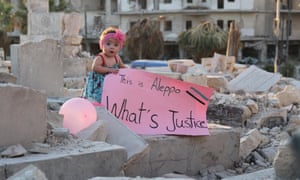
Hamza told her: “Don’t you realise I’m in love with you? Will you marry me?” The film answers his question with footage of their wedding: Hamza in black suit and lilac tie, Waad in a veil with white silk roses in her hair. Confetti falls through the air, as though there might still be room for a fairytale in Aleppo. It is one of the rare times the camera is not in al-Kateab’s hands. They dance to Willie Nelson’s Crazy and Hamza tells her: “This is the road we’re taking, it is a long road full of danger and fear but freedom waits for us at the end.” The tenderness of the dancing is offset by what is, in a sense, their most dangerous wedding vow: “Come, let’s walk it together.”
In the early days, friends would tease: “They’d say: Waad’s playing with her camera again…” This changed after one of their dearest friends, Gaith – a nurse – and his brother Mahmoud were killed in an air raid. “We had lost Gaith,” says al-Kateab. “We knew he was never coming back to this Earth but had this incredible footage of him laughing, working, sad… the life he’d shared was recorded.” Filming was remembering and the people who once mocked now apologised.
Sama’s birth is an ordinary – and extraordinary – event, discreetly presented. We see her friends with ears pressed to the door of the hospital room, listening out for the baby’s first cry and jumping for joy when they hear it. Al-Kateab is then seen crying, holding Sama in her arms – and Hamza teasingly tells her to stop upsetting their baby. What was in her mind? “I was crying because this was a room where two of my friends – Gaith and Omar – used to work before they were killed. I was thinking: I’ve brought life to this place. I’d been terrified I’d not live to see Sama born. I was terrified about the future but also so happy. I could see Hamza’s and my story in Sama’s face. Yet I missed Gaith and Omar and wished they were alive.”
If filming was remembering, it was also, crucially, about resistance. Al-Kateab emphasises new media’s role in the Arab spring: “Mobiles became the only way to show the world that we were fighting for our freedom.” Early student protests were peaceful and festive with fireworks and dancing in the streets. But by 2015, the security forces were beating up student protesters. “They’d turn up and five minutes later, the place would empty. A presenter from the official channel would ask: ‘Has anything happened here?’ ‘No, nothing,’ the remaining students would reply.” Al-Kateab’s footage would capsize that lie. Similarly, she would later secure evidence that Assad’s regime was using chemical weapons.
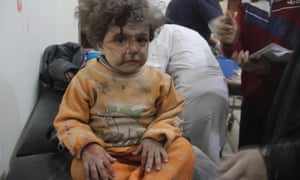
Eventually, filming became her way of surviving: “It gave me a reason to stay in Aleppo. If I was killed, I’d be leaving something important behind.” Not that it gave her distance on what was happening. It was “doubly harrowing” and “brought everything closer”. But for many people, the camera represented hope. And while on the subject, I tell her that, strangely, it was the moments of hope in the film that undid me – all the more moving for being unexpected. A woman who is nine months pregnant is carried into hospital unconscious. An emergency caesarean is performed. We see the baby pulled out – lifeless. The misery of it is sickening. War has killed him. Capable gloved hands palpitate the little chest to start the lungs – surely in vain. The nurse briskly brushes his body with a sweeping movement. They hold him upside down and shake and slap and, just as we have given up on his slippery, grey body, he opens his eyes and cries – and everyone who sees it will join in. God be praised! His furious frown is a triumph, his cry defies Assad (they save the mother as well). “It is a miracle,” al-Kateab exclaims. “It gives us the strength to stay in the struggle.”
But for her, too, hope is hardest to handle: “Whenever I watch the film, it is when everyone else is laughing that I cry. We were creating hope and it was destroyed by the violence of the regime and by the Russians. At the last screening, sitting next to Ed, I started crying as I watched the early days of the revolution. And he was asking me: “What’s the matter?” And I said: “It’s the hope.”
But there has been another, more manageable, version of hope too – in people’s reactions to the film: “It’s been amazing – audiences have given me hope, shown me they really care. I’ve been to Nantucket, Washington, Toronto, and even film distributors, who normally sample a film for 10 minutes and then leave, have stayed and been very moved.” When people went “crazy” in Cannes, she says, “I can’t describe how proud and happy it made me.”
It will be years before Sama is old enough to see the film made in her name. Al-Kateab addresses her in the film like this: “Sama, I know you understand what is happening. I can see it in your eyes. You never cry like a normal baby would. That’s what breaks my heart.” Now she confirms that, on some level, “Sama understood everything. That time I was looking for her during the bombing, I found her sleeping in a very quiet way”. Her second daughter, Taima (she became pregnant again while still in Aleppo, the baby was born in Turkey) reacts in a “totally different way. If a bottle of milk drops, she cries. Sama used to fall from a high bed and not make a sound. But I’d sometimes sense she was scared.”
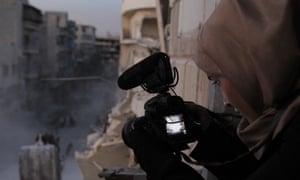
After leaving Syria, Sama used to wake in the night screaming. They consulted experts – she is doing better now. Better than her mother, who says: “I still suffer from nightmares. And whenever I hear a very loud sound – like a train – I feel it in my body. I tried to seek therapy but it did not work for me.” She has said in the past that her therapist (whom she now wants me to know is “amazing” and says she “loves”) herself needed therapy after their sessions together.
The film’s most extraordinary achievement is that, instead of leaving one helpless, it creates resolve. Everyone who sees it feels the same. Al-Kateab says audiences come to her moved and energised and with one question: what can we do? The first step is “understanding”, she says – especially at a point where Idlib’s suffering is starting to resemble Aleppo’s. And she gets out her phone to play the infamous September 2016 interview with US presidential candidate Gary Johnson. Asked about his plans for Aleppo, he replies gormlessly: “What’s Aleppo?” It was this interview that stung Al-Kateab into making the banner seven-month-old Sama holds at the end of the film with their city of ash as a backdrop. It reads: THIS IS ALEPPO. WHAT’S JUSTICE?
As well as the need for understanding, she hopes for support for the campaign she and Hamza plan to launch next month on forsamafilm.com, to “stop bombing hospitals”. She argues that the bombing of hospitals is now a “worldwide” problem. When Hamza’s hospital is bombed, it is observed with sober understatement: “Targeting hospitals breaks people’s spirits.”
Meanwhile, Hamza plans to do a master’s degree in public health and has ambitions to reform the UN and World Health Organization’s approach to conflict areas: “He was put under a lot of pressure by the UN, she says, “to evacuate the hospital in a way that was not to the benefit of his patients. He believes the UN was simply implementing what Russia wanted them to do.”
The film has now been seen at the UN and, at a recent briefing at the UK mission, with ambassadors in attendance. The issue of the bombing of hospitals (with the film as evidence) has also been raised at a security council meeting. And it is hoped that For Sama will be shown to the Russian government (although Watts is mindful of the risk that the Russian regime might “pirate, re-edit or misrepresent it”). And might not showing it in Russia be dangerous for al-Kateab? “It would but I don’t care. I could have been killed three years ago.”
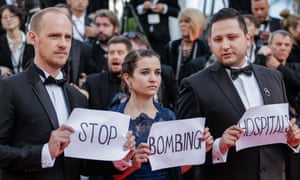
From an outsider’s point of view what seems most striking in the film – bordering on mystifying – is the intensity of the continuing allegiance to Aleppo itself, the wish, expressed repeatedly, to stay no matter what – a vote to put Aleppo before life itself. One of the oldest and most beautiful cities in the world has had its medieval architecture destroyed by barrel bombs. Wouldn’t you run from the wreckage if you could? A boy, with quavering bravado, says he would stay in the city even if his family were to leave. A girl – no more than three – as she is compelled to depart, says in a startlingly adult tone: “Aleppo is gone.” Al-Kateab lets us know: “Saying goodbye is worse than death.”
She nods mutely when I ask if the place itself is precious to her. “A journalist visiting Syria can leave any time. I started with Aleppo in my mind and heart.” She speaks eloquently about shared experience in conflict: “The people I lived with in Aleppo became closer to me than my own parents, sister and brother.” And she makes the point that she and Hamza recognised the necessity of their roles as doctor and journalist.
“We live for the moment we can go back to Syria,” she says, “but it will never happen while the Assad regime rules. If he goes, in the same way that we smuggled ourselves back to Aleppo [after a visit to Turkey] in the film – two headstrong people with a seven-month-old child – we would smuggle ourselves back again.” The memory of their brave return makes her smile. What else can she find, looking back, that is positive?
“Death was close. We knew we could be killed at any moment but lived as if each minute was our last. That’s why there is so much joy in the film. When death is all around you, life is cheap but very important. A lot of people in the UK don’t know the value of life. Or the value of minutes. If you enjoy doing something, do it. If you love someone, tell them as soon as possible because this life could end at any moment.” The world, she continues, is a “very dark place – with Brexit here, US policy, Russia – and you feel nothing will change. But if people keep pushing, things will be changed and there will be justice. And we will keep fighting – no matter how long it takes.”
- “Trump Has Made the Epstein Saga a Case Study in Manipulation”, The New York Times
- “SA likely to support UN General Assembly resolution demanding Russia return abducted Ukrainian children”, The Daily Maverick
- “Honduran Drug Kingpin and Former President Walks Free After Trump Pardon”, National Review
- “Pete Hegseth’s Caribbean lawlessness”, The Washington Post
- “Pete Hegseth Needs to Go—Now”, The Atlantic
- December 2025
- November 2025
- October 2025
- September 2025
- August 2025
- July 2025
- June 2025
- May 2025
- April 2025
- March 2025
- February 2025
- January 2025
- December 2024
- November 2024
- October 2024
- September 2024
- August 2024
- July 2024
- June 2024
- May 2024
- April 2024
- March 2024
- February 2024
- January 2024
- December 2023
- November 2023
- October 2023
- September 2023
- August 2023
- July 2023
- June 2023
- May 2023
- April 2023
- March 2023
- February 2023
- January 2023
- December 2022
- November 2022
- October 2022
- September 2022
- August 2022
- July 2022
- June 2022
- May 2022
- April 2022
- March 2022
- February 2022
- January 2022
- December 2021
- November 2021
- October 2021
- September 2021
- August 2021
- July 2021
- June 2021
- May 2021
- April 2021
- March 2021
- February 2021
- January 2021
- December 2020
- November 2020
- October 2020
- September 2020
- August 2020
- July 2020
- June 2020
- May 2020
- April 2020
- March 2020
- February 2020
- January 2020
- December 2019
- November 2019
- October 2019
- September 2019
- August 2019
- July 2019
- June 2019
- May 2019
- April 2019
- March 2019
- February 2019
- January 2019
- December 2018
- November 2018
- October 2018
- September 2018
- August 2018
- July 2018
- June 2018
- May 2018
- April 2018
- March 2018
- February 2018
- January 2018
- December 2017
- November 2017
- October 2017
- September 2017
- August 2017
- July 2017
- June 2017
- May 2017
- April 2017